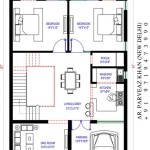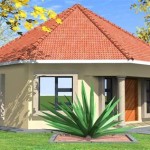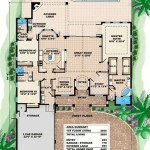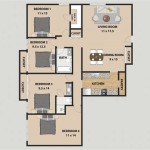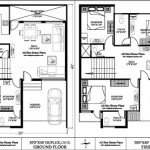House Plans With Walkout Basement & One Story: Maximizing Space and Efficiency
Combining a walkout basement with a one-story house plan presents a unique opportunity to maximize usable space while maintaining the accessibility and aesthetic appeal often associated with single-level living. This type of architectural design is particularly well-suited for properties with sloping landscapes, allowing for seamless integration of the basement level with the surrounding outdoor environment. The resulting structure offers a blend of convenience and versatility, catering to a wide range of lifestyle needs.
The primary advantage of integrating a walkout basement into a one-story house is the significant increase in living area without expanding the footprint of the main level. This is particularly attractive in areas where land is expensive or zoning regulations restrict building height. The walkout basement functions as an additional story, often housing recreational spaces, guest suites, home offices, or storage areas. The defining characteristic of a walkout basement is its direct access to the outdoors, typically through sliding glass doors or a patio, effectively blurring the lines between indoor and outdoor living.
The design considerations for a house plan with a walkout basement and one story are multifaceted. The topography of the lot plays a crucial role in determining the feasibility and cost-effectiveness of this type of construction. Proper drainage and waterproofing are paramount to prevent moisture issues in the basement. Furthermore, the orientation of the house on the lot should be carefully considered to maximize natural light exposure in both the main level and the basement. Finally, the aesthetic integration of the walkout basement with the overall design of the house is important to maintain a cohesive and visually appealing architectural style.
Key Point 1: Advantages of a Walkout Basement in a One-Story Design
One of the most compelling advantages is the expanded living space. A walkout basement effectively doubles the usable square footage of the home without requiring expansive horizontal development. This is especially valuable for families who need extra room for hobbies, recreation, or accommodating visiting guests.
Another significant benefit is the integration of the basement level with the outdoor environment. The walkout feature transforms the basement from a potentially dark and isolated space into a bright and inviting extension of the home. This direct access to the outdoors facilitates easy enjoyment of the yard and creates opportunities for outdoor entertaining. A patio or deck extending from the walkout basement can serve as an ideal space for barbecues, relaxing, or simply enjoying the fresh air.
Increased property value is also a noteworthy advantage. Homes with walkout basements tend to command higher prices in the real estate market compared to similar homes without this feature. The added living space, enhanced functionality, and seamless connection to the outdoors all contribute to the overall desirability and market value of the property.
Finally, a walkout basement can offer enhanced flexibility in terms of usage. The space can be adapted to suit a variety of needs over time. It can function as a family room, home theater, gym, office, or in-law suite. This adaptability makes it a valuable asset for homeowners who anticipate changing needs in the future.
Key Point 2: Design Considerations for Sloping Lots
The slope of the lot is the defining factor in whether a walkout basement is feasible and how it will be designed. A moderate to significant slope is ideal, as it allows for the back of the basement to be exposed at grade level, creating the walkout feature. Sites with minimal slope may require extensive excavation and retaining walls, which can significantly increase construction costs.
Drainage is a critical consideration when building on a sloping lot. The design must incorporate proper drainage systems to effectively manage runoff and prevent water from accumulating around the foundation. This may involve the installation of French drains, swales, or other water diversion techniques. Properly managed drainage is essential to prevent moisture problems in the basement and ensure the long-term structural integrity of the home.
Foundation design is another important aspect of the design process. The foundation must be structurally sound and able to withstand the pressure of the surrounding soil. In some cases, reinforced concrete walls may be necessary to provide adequate support. The foundation should also be properly waterproofed to prevent water from seeping into the basement.
Furthermore, the orientation of the house on the lot should be carefully considered to maximize natural light exposure in both the main level and the basement. Ideally, the walkout portion of the basement should face south or west to take advantage of sunlight throughout the day. This can help to create a brighter and more inviting space in the basement.
Key Point 3: Functional and Aesthetic Integration
Achieving a seamless functional integration between the main level and the walkout basement is crucial for maximizing the usability of the home. A well-designed staircase is essential for providing easy access between the two levels. The staircase should be located in a central area of the house and should be wide enough to accommodate comfortable traffic flow.
The layout of the walkout basement should be carefully planned to optimize the available space and create functional zones. Consider how the space will be used and design the layout accordingly. For example, if the basement will be used as a family room, the layout should include ample seating areas, a media center, and space for recreation. If the basement will be used as a guest suite, the layout should include a bedroom, bathroom, and sitting area.
Aesthetically, the walkout basement should be designed to complement the overall design of the house. The exterior finishes of the walkout portion of the basement should match or coordinate with the finishes of the main level. This will help to create a cohesive and visually appealing architectural style. The landscaping around the walkout area should also be carefully planned to enhance the natural beauty of the site and create a welcoming outdoor space.
Consider incorporating large windows and sliding glass doors to maximize natural light exposure in the basement. This will help to create a brighter and more inviting space. The windows and doors should be strategically placed to take advantage of views and enhance the connection between the inside and outside.
The interior design of the walkout basement should also be consistent with the overall design of the house. Choose flooring, paint colors, and furnishings that complement the style of the main level. This will help to create a cohesive and harmonious living environment.
Lighting plays a crucial role in defining the ambiance of the basement. Use a combination of natural light and artificial light to create a bright and inviting space. Consider incorporating recessed lighting, pendant lights, and wall sconces to provide ample illumination. Use dimmers to control the intensity of the light and create different moods.
Proper insulation is essential for maintaining a comfortable temperature in the basement. Insulate the walls and ceiling to prevent heat loss in the winter and heat gain in the summer. This will help to reduce energy costs and create a more comfortable living environment.
Ventilation is also important for maintaining air quality in the basement. Ensure that the basement is properly ventilated to prevent moisture buildup and mold growth. Install exhaust fans in the bathroom and laundry room to remove excess moisture. Consider installing a dehumidifier to control humidity levels in the basement.
Finally, consider incorporating soundproofing measures to minimize noise transmission between the basement and the main level. This is particularly important if the basement will be used as a home theater or music room. Install soundproof insulation in the walls and ceiling to reduce noise transmission. Use solid core doors to minimize noise transmission between rooms.
In summary, integrating a walkout basement into a one-story house plan requires careful consideration of various factors, including site topography, drainage, foundation design, functional integration, and aesthetic consistency. By addressing these considerations thoughtfully, homeowners can create a valuable and versatile living space that enhances the overall functionality and value of their property.

Country Ranch Plan 3 Bedrms 2 Baths 1902 Sq Ft 150 1014

Photos Of Plan 1117 The Clarkson Basement Floor Plans House

Plan 027h 0140 The House

The Best House Plans For Sloped Lots And Narrow Houseplans Blog Com

Small Cottage Plan With Walkout Basement Floor House Plans

The Best House Plans For Sloped Lots And Narrow Houseplans Blog Com

Rustic Mountain House Floor Plan With Walkout Basement Ranch Style Plans

The House Designers Thd 1143 Builder Ready Blueprints To Build A Country Plan With Walkout Basement Foundation 5 Printed Sets Com

Plan 80862 Modern Small Farmhouse With 1263 Sq Ft 2 Beds

Y4h0406 Frow Design

